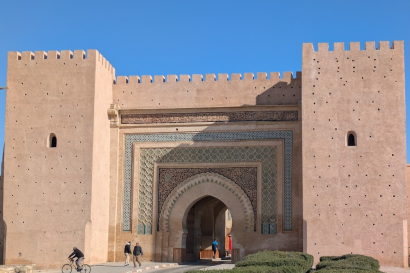
Moroccan food is carb and meat-heavy and laden in unique spices and oils. At home, many families eat with their hands from one giant, round plate. Various types of bread or cous-cous is served with each meal to use instead of silverware. Cous-cous is a rice-like grain that can be balled up and used like bread to pick things up (a necessary skill to acquire immediately!).
In the morning before class, my host mom keeps meals small and similar to a traditional European breakfast. It’s usually khubs (bread) or melwih, a Moroccan crepe, served with cheese, jam, Nutella, honey, butter, or oil. My host mom also recently found out that my roommate and I love peanut butter, and she has been leaving out a jar for us. Freshly-squeezed juice is also very inexpensive and popular in almost every restaurant here, something I will deeply miss upon returning to the U.S.

Lunch is biggest meal of the day, and people don’t even consider eating until after 2. It typically starts out with a “salad” which is a giant cluster of beets, cabbage, shredded carrots, corn, cucumbers, diced potatoes, tomatoes, olives, and often a dressing of some sort on the side. It’s easy to really fill up on the fresh vegetables, but it’s important to save an ample amount of room for the tajine or cous-cous!

Tajines are shallow ceramic bowls with a ceramic cone piece on top used to steam large amounts of food all together. It typically consists of a meat (lamb, beef, or chicken), potatoes, carrots, onions, red peppers, sometimes olives, sometimes dates, and broth. I have also seen the occasional guest appearance of a sweet potato or squash. It took me a while to get the hang of the art of picking up food with bread, and after a couple weeks I stopped feeling guilty about picking up potatoes with bread. When in Rome, right?
Meals with cous-cous are a big family event here and they are typically served for lunch on Fridays, which are traditionally the day of the week for the family to spend time together. Food prepared in a tajine is piled on top of a large circular plate of cous-cous, and each person gets an unofficial triangle of the food mountain to themselves.

I am becoming more talented at eating with my hands every day and share a plate of food with my roommate for every meal. I have to admit that it has been a cultural adjustment and I sometimes I get a little freaked out and germaphoby during cous-cous events when the whole family (including my 8 year-old and 12 year-old brother who spend their days playing outside) has their hands in my food…but my discomfort is definitely not worth missing out on the food!
After all that cous-cous, dinner is a small ordeal and we often have a light serving of eggs, soup, pasta, or lentils between 9pm and 11pm. The hours between lunch and dinner feel much longer than in the US, but evenings are a great time to have some Moroccan mint tea.

I learned how to make the tea from some Moroccan friends. Mint leaves and lots of cubes of sugar are all boiled together and it is supposed to be poured from as high as possible into a small glass (I rarely see mugs for tea). Mint tea is an iconic part of the culture and our institute even serves it every morning at 9:00 in the middle of the long Arabic class.

Morgan Mccullough
<p style="margin-bottom:12.0pt">I am a Michigan native studying Global & International Studies, Arabic, and Spanish. I am a slow traveler and I value getting lost, staying with locals, and learning new languages and traditions. This fall, I am eating my way through the amazing food of the Maghreb and asking a lot of questions about camels, how to barter, and how to say “more tea please?” in Darija<span style="text-autospace:none"><span style="font-size:16.0pt"><span style="font-family:"Times",serif"> </span></span></span></p>








